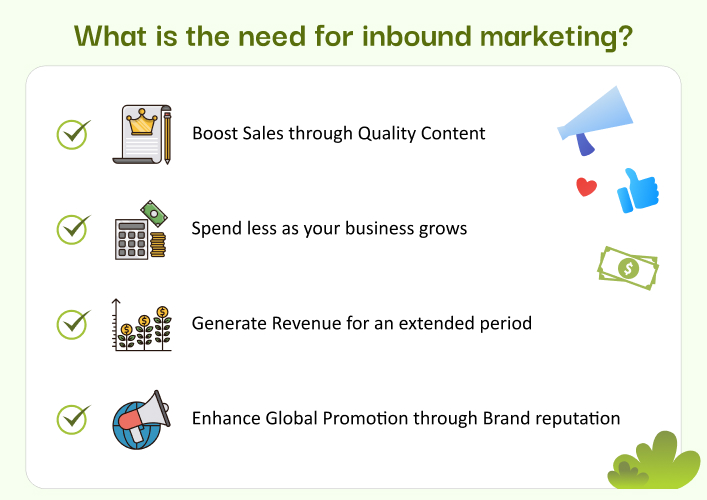What is the need for inbound marketing?

The long-term profitability offered by this marketing strategy for online stores is what attracts the most attention. Furthermore, it helps in saving the finances. The expenses spent on inbound marketing are mostly the price of tools or salary. Thus, this marketing strategy will give fruit in the long run. Some of the advantages are as follows:
- Good quality content is essential. More sales will result from content.
- The majority of your money will be spent in the beginning, but that will decrease dramatically as your business grows.
- Inbound digital assets have a very long life span, during which they generate revenue for you.
- The effect on the brand’s reputation aids in global promotion.
What are the steps to launch inbound marketing?
Due to the time and effort required to establish a marketing strategy, careful preparation is essential to achieve success. Here are the steps for launching a successful marketing campaign.
Set goals
The goals you set for yourself will change depending on the medium you use. Establish the primary indicators by which you will monitor progress and evaluate results. For example traffic, multi-channel contribution, conversion rate, ROI, etc. Simple math using typical conversion rates can help you determine your desired volume of visitors or pageviews.
Know the customers
Identifying your target market should be your next step. Find the answer of what are their most common queries. An inbound sales strategy for an online store will succeed or fail depending on how well the question is answered and buyer personas are developed. Study the population structure and dynamics, examine search terms, know the impact of social media, and create buyer personas to use to guide your content creation, publication strategy, and promotion efforts.
Have a content plan
Make a strategy for how you’ll accomplish the tasks once you know what it is you’ll be doing. It’s tough when it comes to creating engaging content that draws in new consumers. Try out your approach for at least a quarter and see whether it pays off.
What are the inbound marketing strategies for e-commerce?
Let’s explore some of the strategies for e-commerce.
- SEO: Many e-commerce sites write blogs on topics related to their niche. Blogging is not the only way for SEO. You need to make your website easy to crawl, put relevant keywords in the content, update or add content on the site regularly, etc. Add alt texts to product images to rank on search engines.
- Guest Posting: It is challenging for a new eCommerce firm to get their website to rank on page one of Google. Instead, you should focus on contributing to high-quality, established websites. When you do guest posting, customers who are reading that site and trust it will trust you as well. Furthermore, when Google recognizes your posts, it will give your own site’s postings more importance.
- Instagram: For new online merchants with a limited budget, selling on social media is a great option. Because people are already familiar with engaging with companies on social media and because the advertisements cost less than those on Google, they are more likely to click on them. You can make shoppable posts on Instagram and even conduct transactions inside the app.
- Forms or Surveys: Make it easier for a potential or current client to get in touch with you by a contact form or email address. You shouldn’t only focus on making the purchasing process simple and mobile-friendly; you should also think about how message and merchandising might affect sales.
- Loyalty programs: Creating a customer loyalty program that rewards customers on the basis of their spending is the best approach to encourage repeat business. Even if it’s impractical to give consumers actual presents on their birthdays or on the anniversaries of their purchases, you might still show your appreciation by providing them with a special discount.
Conclusion
Content development, search engine optimization, social media interaction, email marketing, and data-driven decision-making are all cornerstones of inbound marketing. The goal is to provide customers with experiences that they find interesting, useful, and enjoyable. When carried out properly, it may propel businesses across many sectors to sustainable development and prosperity.
FAQs
What is inbound marketing?
How does inbound marketing differ from outbound marketing?
What are some key components of inbound?
Why is content creation important in marketing?
How can businesses measure the success of inbound campaigns?
Ravi Bhojani is the Chief Marketing Officer (CMO) at Alian Software, where he spearheads the company’s marketing strategies and drives its brand presence in the competitive IT services landscape. With over a decade of experience in the technology and marketing sectors, Ravi has consistently demonstrated his ability to blend innovative marketing techniques with deep industry knowledge to deliver outstanding results.